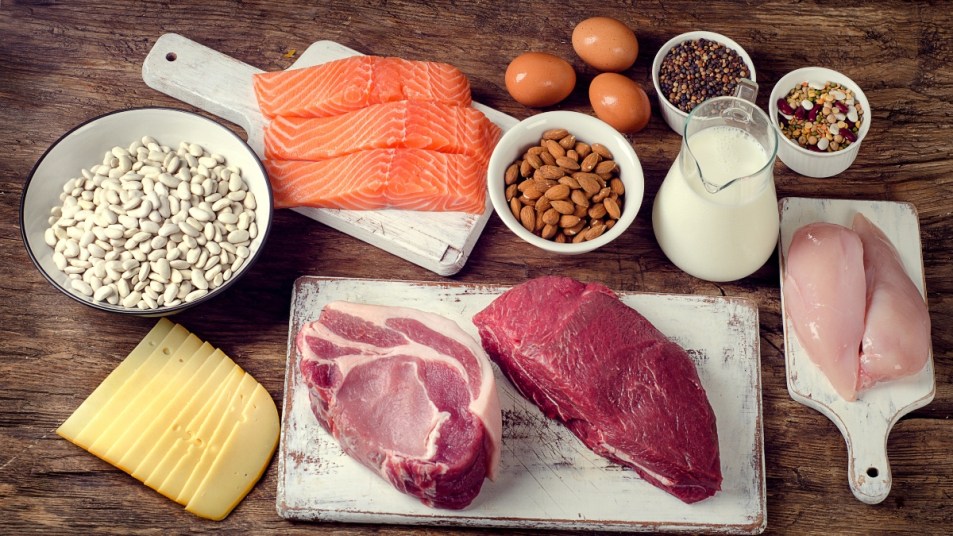Eating This Kind of Protein May Lower Your Risk of High Blood Pressure, Study Shows

If your doctor says you need to lower your risk of high blood pressure, mealtime may look different than it has in the past. Less salt, less fat, and more protein are standard orders in a cardiac diet. However, a new standard could soon make its way onto your plate, after a recent study showed that eating a greater variety of proteins may help lower your risk of developing high blood pressure. Turns out, the type of protein you eat may have a big impact on your cardiovascular health.
A Closer Look At the Study
Published on March 10 in Hypertension, a peer-reviewed journal of the American Heart Association, the study explored the impact of protein intake and variety on 12,177 adults living in China. All participants took part in the China Health and Nutrition Survey, an ongoing project that measures the nutritional and health status of the Chinese population.
Survey rounds typically occurred every two to four years, and in order to qualify, the participants had to have completed at least two rounds of the survey between 1997 and 2015. (Why two rounds? The researchers used the participants’ initial surveys as a baseline so they could track health and dietary changes in the second set of surveys.) About 53 percent of the adults were women, and the average age among all participants was 41.
After analyzing the participants’ diets, the study authors gave each adult a protein “variety score” based on how many sources of protein they ate. The authors counted eight sources of protein in total: whole grains, refined grains, processed red meat, unprocessed red meat, poultry, fish, egg, and legumes (beans, peas, and lentils).
Then, the researchers determined how many of the adults had developed high blood pressure (BP) since their initial surveys. The team defined hypertension as having a systolic (top number) BP greater than or equal to 140, and a diastolic (bottom number) BP greater than or equal to 90.
The Benefits of Eating a Wide Variety of Proteins
Overall, more than 35 percent of the participants had developed high blood pressure by the time researchers followed up with them. However, adults who had the highest protein variety score — meaning they ate at least four or more types of protein — were 66 percent less likely to develop high blood pressure as compared to those who ate fewer than two protein varieties.
There was a small catch: The study authors found that for each type of protein, there was a “window of consumption,” or appropriate intake level, that linked to better blood pressure levels. In other words, each type of protein was beneficial to a point — moderation and variety seemed to be key. In addition, both extremes (eating too much protein or not enough) seemed to be bad. Those who ate the least amount of total protein and those who ate the most had the highest likelihood of developing hypertension.
Things to Keep in Mind
It’s important to take this research with a few grains of salt. The findings suggest that eating varied protein may prevent high blood pressure, which doesn’t necessarily mean that eating varied protein will lower existing high BP numbers.
Also, each round of survey data was based on three days of a person’s diet. The researchers didn’t know the exact daily diets of the participants beyond those three days, and they couldn’t control exactly what the participants ate. As a result, they could not definitively prove that any amount or kind of protein causes or prevents high blood pressure.
Still, the findings are important, because they give us an idea of how best to lower our risk of hypertension. A press release from the American Heart Association (AHA) noted that high blood pressure is one of the leading contributors to heart disease. Eating a varied diet can greatly reduce that risk.
What protein varieties should you eat?
The AHA recommends that we get most of our protein from plants, and some from seafood and low-fat or fat-free dairy products (think nonfat Greek yogurt). You can also add lean cuts of unprocessed poultry and other meats to your protein intake, if you enjoy them. About one to two servings of protein daily, which is 5.5 ounces each, should do the job.
So, stock up on those nuts, beans, and lentils! Try peanut butter powder if you’re limiting your fat intake, whip up a delicious lentil soup, and add color to your plate with fava beans. Before you know it, you’ll be eating a wider variety of proteins than ever before.












